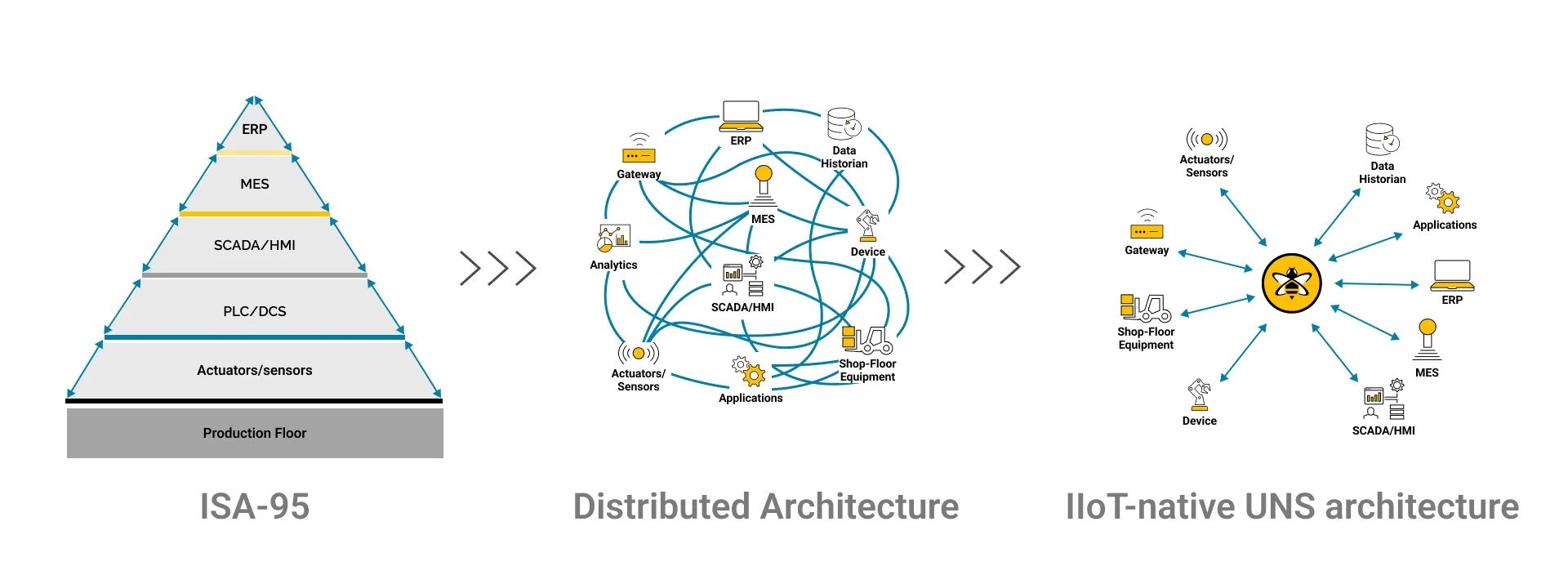Bringing Clarity to the Unified Namespace Approach
HiveMQ has been sharing guidance on building a Unified Namespace for several years, since soon after the term was coined by Walker Reynolds. Through our practical experience helping customers understand and build their Unified Namespace, we’ve gained valuable insights that led us to evolve our thinking on how to implement this approach effectively in the real-world.
Today we start a four-part blog series to explain our refined thinking around UNS, the elements needed to architect this single source of truth for operational data, and ultimately make a case for why the industry needs a better solution to simplify building a UNS to bring data intelligence from edge-to-cloud.
The Evolution of the Unified Namespace
The Unified Namespace has evolved alongside industrial and operational technology landscapes. Initially, many systems followed the ISA-95 automation pyramid, a hierarchical approach where data flowed linearly between layers. This setup, while effective at the time, often led to siloed data and inefficiencies.
As industries embraced distributed architectures, such as OPC-style configurations, the approach became more decentralized but also more complex—earning it the nickname "spaghetti architecture." While this structure improved connectivity, it lacked the cohesion and scalability needed for modern industrial ecosystems.
Today, the UNS represents the next stage of this evolution: an IIoT-native architecture. By shifting from inflexible, point-to-point integrations to true UNS architectures, organizations gain the ability to unify data from edge to cloud seamlessly. This transition supports real-time data transformation, actionable insights, and scalable intelligence across diverse environments.

So, What is a UNS Again?
A Unified Namespace (UNS) is an architecture and design pattern for structuring data producers and consumers within a real-time industrial operations environment. It serves as a single source of truth for an enterprise’s operational data by providing a structured directory where all devices, applications, and systems publish and consume data in a unified, organized manner.
There’s been some debate about whether a UNS is a concept or an implementation, and the answer is both:
As a concept, UNS is a framework for organizing industrial data and making it available in the right place, to the right people, at the right time.
As an implementation, it is a real-time data platform in the same way that we build enterprise data platforms to deal with our historical data.
Most definitions of the Unified Namespace focus on the implementation - the architecture and characteristics that a UNS should have. Those details are important and we’ll get to them in the next blog, but we feel it is important to talk about what a UNS does before talking about what a UNS includes.
What Does a Unified Namespace Do?
At its core, a Unified Namespace turns data into information and information into insights.
Data is raw, unstructured, and often lacks context—coming from thousands of sensors, PLCs, and applications.
Information is created when data is contextualized, giving it meaning within business operations.
Insights emerge when that information is analyzed and applied to answer critical questions like how, why, when, or where an event occurred.
Without a UNS, organizations struggle to harness the full value of their operational data, leading to delays, inefficiencies, and missed opportunities for optimization.
A well-architected UNS solves this by:
Bridging the OT/IT divide – Enabling seamless communication between machines, sensors, enterprise applications, and cloud platforms.
Providing a real-time data pipeline – Moving data across systems without delay, ensuring organizations can react instantly.
Ensuring data integrity and consistency – Making sure the data is reliable, trustworthy, and structured for use.
Supporting scalable deployments – Whether for a single factory, a global enterprise, or an entire supply chain, a UNS can scale to fit the organization’s needs.
The Role of HiveMQ in the Unified Namespace
Today, HiveMQ is the most trusted platform for moving industrial data reliably and securely in real time. Our MQTT platform lays the foundation for a scalable, high-performance UNS, ensuring that data flows efficiently from edge to cloud with reliability, security, and scalability. Companies like Anglian Water and others are already using HiveMQ for the basis of their UNS.
But data movement is only the beginning. As organizations mature in their UNS adoption, they require more than just data transport—they need capabilities that transform raw data into business insights. Right now a lot of the work is manual and building a UNS takes time and effort. The future of UNS will include advanced data transformation, governance, contextualization, and tooling that makes it easier to build and enforce a UNS from edge-to-cloud. At HiveMQ we are continually innovating to simplify how organizations harness their real-time operational data.
What’s Next?
In the next blog in this series, we’ll break down the key building blocks of a Unified Namespace, including how to design, implement, and maintain an effective UNS for industrial environments. Stay tuned as we explore how HiveMQ is making it easier for enterprises to unlock the power of their operational data.

Magnus McCune
Magnus is a Principal Architect at HiveMQ. He is a passionate technologist with a proven background solving complex business and technical challenges through the design, implementation and operationalization of cloud and edge technologies. His expertise extends to network, cloud, & infrastructure architecture, cloud-native solutions design and large-scale automation projects.
